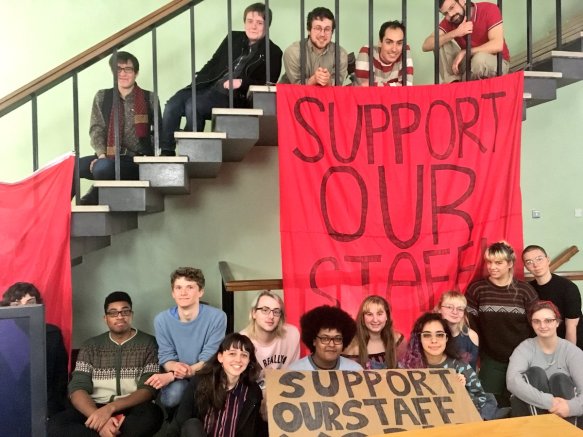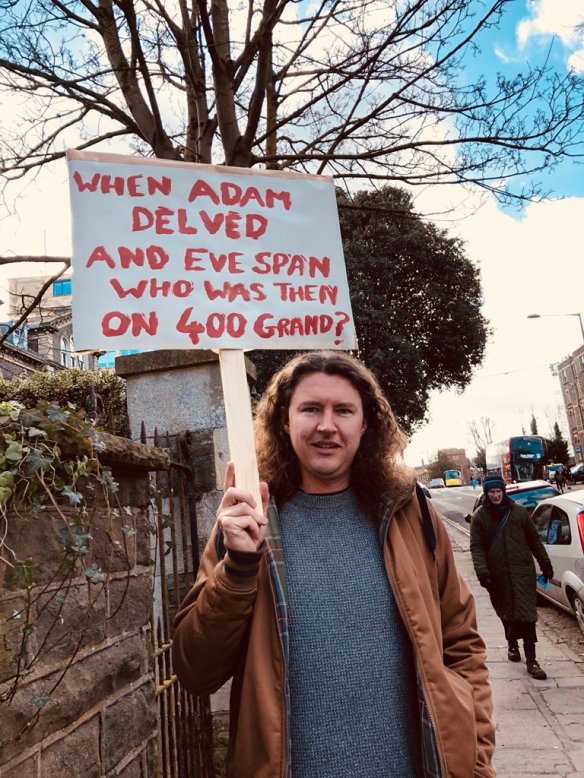Brodie Waddell
I’m not a labour relations expert, nor a union organiser, nor a seasoned activist. I am, however, a lecturer who has been on strike over the past few weeks alongside tens of thousands of other university staff.
As historian of, roughly, the seventeenth century, I’ve felt frustrated that I could add so little to the wonderful teach-outs on contemporary politics or to the brilliant online commentary on the technicalities of the dispute. I’d be useless at trying to predict what is going to happen next and I can’t even offer any practical advice to our tireless UCU representatives who are trying to save our pensions. The only thing I can hope to contribute is a few thoughts on some of the echoes – and dissonances – between those long-past struggles and our own.
Striking isn’t just about striking
The current strike started when UCU members voted overwhelmingly to withdraw their labour in an attempt to get our employers to negotiate, rather than simply impose a new poorer, riskier pension scheme. This refusal to work is what defines a strike. It is painful: students don’t get taught, research grinds to a halt, administrative services slow or cease, and we don’t get paid. This is also precisely why it is such an important tactic if we want our employers to compromise.
But it is hardly the only tactic being used during this strike. It is merely a small part of a broader ‘strike culture’.
We also have set up picket lines at every striking university. We are not only withdrawing our participation in the university, but also directly urging other people to do the same, whether students, non-striking union members or simply sympathetic members of the public.

Two historians on the picket line at Birkbeck
We have joined marches to draw attention to our strike, aiming to raise awareness among decision makers – hence the recent marches to Westminster – and the public through the media.
We have used twitter, facebook, blogs and other media platforms to both organise our actions and promote our cause.
We have launched ‘teach outs’ to share our strike-related knowledge in unconventional ways with people who might never end up in our classrooms.

The student occupation at the University of York
We have been supported by direct action from our students, ranging from a friendly email to us, a strident letter to our employers, and at least 16 cases of sympathetic ‘occupations’. Students obviously have their own interests and priorities, but the remarkable solidarity they have shown has helped hugely to counteract some of the frustrations we have all experienced over the last few weeks.
Perhaps most importantly of all, both strikers and their supporters have gone far beyond these purely ‘practical’ actions by creating a wider ‘strike culture’. I can’t help but grin whenever I come across some clever new placards, songs, chants, costumes, baked-goods, collective knitting or – my personal favourite – the famed Dinosaur of Solidarity.

The Blanket of Solidarity, knitted collectively on the Exeter UCU picket line
What struck me as I watched this unfold – both on the pickets and on social media – is the parallels with the range of tactics used by the people I study for a living. (As I wrote this on strike, I won’t cite anything based on my recent unpublished research. I’ll simply provide a few examples from a previous publication.)
Although the ‘strike’ is a tactic normally associated with modern labour unions, some of the earliest large-scale examples of this expression of worker solidarity can be found among the men of the naval dockyards in the 1660s. At Woolwich, for example, an official reported ‘the great discontent among our workmen’ that arose when they were banned from collecting scrap wood – a customary perquisite known as ‘chips’ – in the spring of 1665. It began on 3 April when ‘about fifty of them, all strangers, refused to come this morning to work’, and the next day it had spread to ‘a great number of our townsmen [who] exempted themselves from their work … so that 139 in all stand out on their privilege of chips’, leaving very few in the yard. The official recommended granting them ‘the liberty … of carrying off lawful chips twice a day’.
What is even more noticeable is that ‘pre-union’ workers did not merely withdraw their labour. They also deployed a wide range of other tactics.
In the south west in the early eighteenth century, large groups of weavers collectively petitioned parliament on some occasions and attacked the looms of ‘several Masters who opposed their Laws’ on others. Alongside these concrete actions, they set up set up illicit ‘clubs’ and ‘fraternities’ where they developed a distinctive fraternal culture. By 1708, one ‘Club’ had ‘a common Seal, Tipstaffs, and Colours, which they display at Pleasure, and meet, as often as they think fit, at their Club-house, being an Inn at Taunton’, and in 1726 Mr William Pike, an employer, reported having ‘seen the Weavers at their Clubs, where none but Weavers are admitted; and that they have their Ensigns and flags hung out at the Door of their Meetings’. These workers expressed their collective identity unapologetically, and their labour actions were no doubt stronger for it.

The ‘colours’ of the London Tin Plate Workers (1821), the oldest surviving trade union banner, held at the People’s History Museum in Manchester
* * *
Obviously, we should not imitate the violence and vandalism used by these early strikers. But the importance of their sociable meetings at inns and the display of their ‘colours’ is worth noting. The ‘material culture’ and personal camaraderie that emerged from their organising was probably vital to their solidarity.
We should, therefore, embrace the diversity of tactics that the strikers and our allies have been using. Not all of us can regularly make it to the picket line and still fewer can promote our perspective in a newspaper column.
Nonetheless, we can adopt a convivial, welcoming approach to striking that more fully acknowledges and supports the breadth of contributions that everyone has been making.

Fact: Social historians make the best picket-line placards

Pingback: Striking parallels, c.1700 and 2018 (part 2) | the many-headed monster
Pingback: 9. Holding the line – narrative of a strike
Here’s a different comparison, although one which is likely to provoke ire: 2018 and 1968. In the 1960s, there was an alliance between academics and wider society which invoked collective action about wider social conditions, not least Students for a Democratic Society in the USA and the soixante-huitards in France. That active collaboration does not appear to exist in 2018: students and academics are addressing a narrow issue in HE. Although they regard it as symbolic of wider social issues, the locus is closely defined. The activity is on the campus, not the ‘streets’. The alliance between academia and workers seems to be absent. The 1960s’ movements failed, of course, and had a deleterious effect as one strand promoted the narcissism and selfishness which allowed Thatcher’s creed. OTOH, a vital strand has been seemingly lost.
Sorry about the delayed reply! Yes, this is definitely not a repeat of ’68. It is, as you say, a much smaller and more sectorally narrow movement, through the alliance with activist students seems to make it rather different from most HE strikes in recent decades. The goals also seem a lot more acheivable than in ’68. Most strikers aren’t trying to bring about social revolution – a decent pension would be enough to get us back to work.
Pingback: Jobbing Historians: Tales from the Blarchive | the many-headed monster